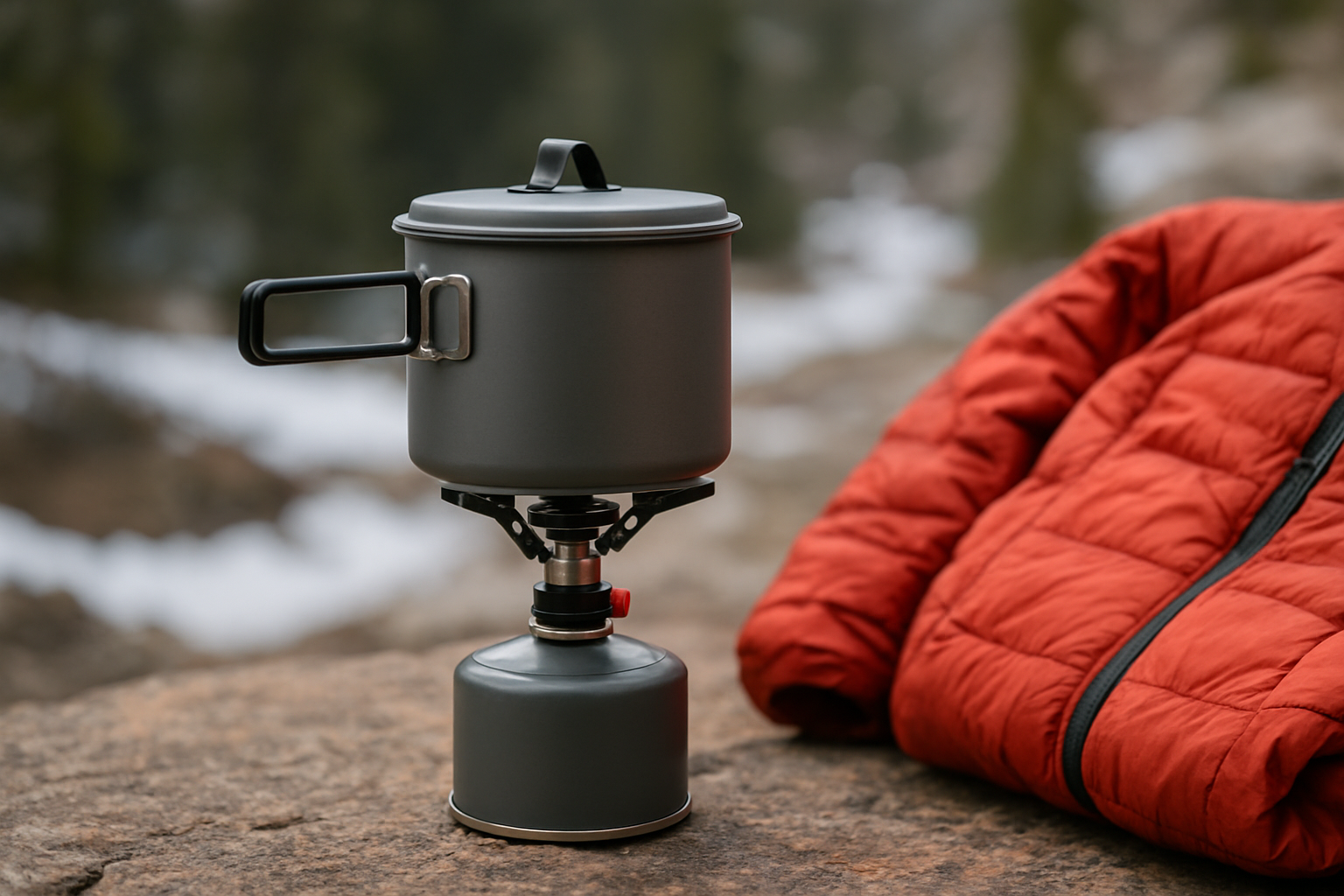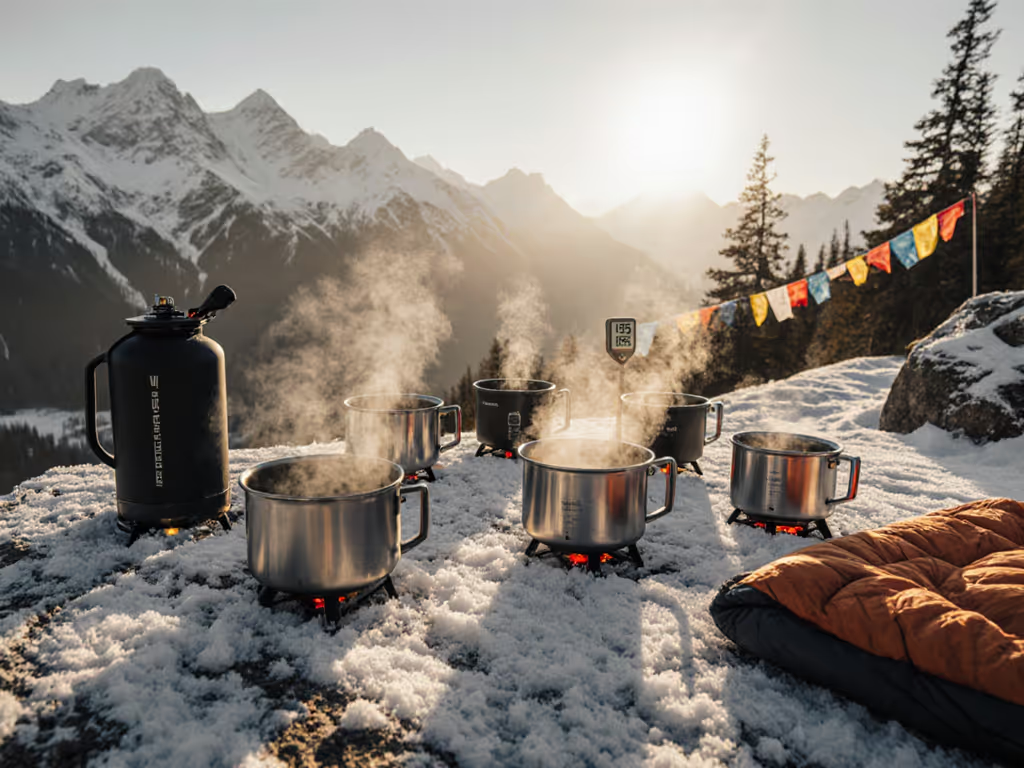Top 7 Trip-Tuned Stove Setups for 2025-11-08: Heatinerary’s Cold-Weather Picks for Camping, Fuel & Cookware
Top 7 Trip-Tuned Stove Setups for 2025-11-08: Heatinerary’s Cold-Weather Picks for Camping, Fuel & Cookware
Have you ever tried to light a stove on a ridge when the mercury hovers near 15°F (15 degrees Fahrenheit) and the wind slices through gloves like paper? This blog post for 2025-11-08 lays out Heatinerary’s top seven cold-weather stove setups, each matched with the right fuel and cookware so your meals are reliable, fast, and safe. Because when temperatures plunge, the wrong choice wastes fuel, delays dinner, and raises risk, while the right mix turns winter cooking into a calm routine. Drawing on Heatinerary’s Trip-Tuned Stove Lab for precise stove, fuel, and cookware matching, we combine field data, lab measurements, and real-world stories to help you choose with confidence.
Why This blog post for 2025-11-08 Matters for Cold-Weather Cooking
Cold air drains pressure from canisters, slows vaporization, and punishes inefficient pots, so performance gaps that are minor in summer become decisive in winter. A common isobutane canister loses most of its punch as vapor pressure drops from roughly 45 psi (pounds per square inch) at 70°F (70 degrees Fahrenheit) to near 17 psi at 32°F (32 degrees Fahrenheit), according to manufacturer charts, which lengthens boil times and can cause sputtering. Not sure when to switch categories? Start with our canister vs liquid fuel guide for cold-weather decision-making. Wind multiplies the problem by stripping heat from pots; even a 5 mph (miles per hour) breeze can double boil times if you skip a windscreen. And at altitude, thinner air reduces oxygen availability, so flame patterns that were stable at sea level can lift and flutter at 10,000 ft (feet), further widening the gap between stove types and cookware pairings. For a data-driven breakdown of high-elevation cooking, see our high-altitude stove testing.
That is exactly why Heatinerary exists: to remove guesswork and replace it with tested matches tailored to where you are going. Our readers tell us the hardest part is not buying a stove but understanding which fuel blend, pot geometry, and wind management plan will still work at 12°F (12 degrees Fahrenheit) on a tilted snow bench. With a focus on cooking efficiency across weather and elevation and clear comparisons of stove fuels for subzero performance, we translate technical details into practical choices. In short, you will know what to pack, how to deploy it, and what to do when conditions shift mid-trip.
How We Trip-Tune Stove Setups at Heatinerary
Trip tuning starts with your route profile: expected low temperatures, wind exposure, elevation bands, daily water needs, and group size. In Heatinerary’s Trip-Tuned Stove Lab for precise stove, fuel, and cookware matching, we simulate these conditions in controlled tests, then validate the pairings outside on real trips. We track boil times for 1 L (liters), simmer stability with 500 ml (milliliters) workloads, and fuel mass consumed per task to compute fuel use (grams or ounces per liter boiled and per simmer). We also log flame behavior under crosswinds measured at 5 to 15 mph (miles per hour), and we monitor pot temperature profiles to detect cold spots and hot rings that cause scorching or wasted heat.
Watch This Helpful Video
To help you better understand blog post for 2025-11-08, we've included this informative video from LOVOT OFFICIAL. It provides valuable insights and visual demonstrations that complement the written content.
Next, we score safety and usability. That includes pump reliability in liquid-fuel stoves, regulator performance in micro-regulated canister stoves, and heat transfer characteristics of pots with and without heat exchangers. We provide guidance on carbon monoxide (CO) risks during snow-melting sessions, a time when ventilation and pot selection are critical. Finally, we rank each setup by context: solo overnights, family basecamps, technical mountaineering, and fast-and-light missions. The result is a short list of options where each component is chosen to solve a specific problem you will actually face, not a theoretical one.
The Top 7 Trip-Tuned Stove Setups for Subzero and Shoulder-Season Trips

Below are seven complete setups curated for winter reliability and early spring or late autumn flexibility. Each one pairs a stove type with the right fuel and cookware, plus the wind and surface aids that transform raw heat into dependable meals. Think of them as modules you can swap depending on the coldest night on your forecast, your team size, and how exposed your campsites will be. As you read, imagine your route: are you melting snow daily, cooking one-pot dinners for four, or brewing quick coffee at windy passes? The answer will point to your best match.
- Polar Ridge Remote-Canister, Inverted-Feed System: Runs a canister upside down for liquid feed through a preheat loop, stabilizing output between about 10°F and 32°F (10 to 32 degrees Fahrenheit). Pair with a 1.1 L (liters) heat-exchanger pot and a full-height windscreen that leaves safe ventilation clearance. Ideal for solo to duo trips above treeline.
- Deep Cold White-Gas Pump Stove: Pressurized white gas thrives below 0°F (0 degrees Fahrenheit) and remains reliable to about -40°F (-40 degrees Fahrenheit) with proper priming. Choose a wide, 2 to 3 L (liters) hard-anodized pot, a baseboard for insulation, and a rigid windscreen. Best for groups of two to four melting snow daily.
- Wind-Lock Integrated Canister Cup System: For shoulder seasons around 20 to 45°F (20 to 45 degrees Fahrenheit), an integrated burner and cup with a locking heat exchanger excels at fast boils. Use a partial windscreen and keep the canister in a pocket before use. Designed for solo hikers who value speed and simplicity.
- High-Altitude Multi-Fuel Expedition Stove: Burns kerosene or white gas with swappable jets and a robust preheat tube, giving stable flames in thin air. A 3 L (liters) pot with a heat diffuser plate covers snow-melt duty and group meals. Favored for remote routes where fuel flexibility is mandatory.
- Ultralight Alcohol Cone System: Above roughly 25°F (25 degrees Fahrenheit) with sheltered camps, a cone windscreen and 900 ml (milliliters) pot create efficient, quiet cooking. Plan extra time, carry backup fuel, and use a lid religiously. Works for minimalists who cook simple meals and hot drinks.
- Family Basecamp Propane Two-Burner: A tabletop LPG (liquefied petroleum gas) stove with built-in windscreens and a stable griddle area handles pancakes, pastas, and cocoa for a crowd (family camping stove picks). Use 1 lb (pounds) cylinders with an adapter or a bulk tank with hose. Suited to car-accessible winter camps above about 15°F (15 degrees Fahrenheit).
- Pocket Solid-Fuel Emergency Kit: Hexamine tablets and a small folding stand are not glamorous, but they are a failsafe if your primary system falters. Reserve for day hikes or backup, and always ventilate well. Boils are slow; plan it as a redundancy, not a primary.
Fuel, Pot, and Wind Management: What Changes Below Freezing
Fuel behavior is the heart of cold-weather performance. Canister blends rely on vapor pressure, so as temperatures drop, propane-rich mixes outperform straight isobutane. Dive deeper into fuel chemistry in our propane vs butane vs white gas analysis. Liquid fuels sidestep that constraint by letting you add pressure manually with a pump, but they ask more from the user during priming and maintenance. Alcohol and solid fuel still work when handled carefully, yet their lower energy density means longer boil times and tighter wind control. Whatever you choose, a wind strategy is non-negotiable: a wrap-around windscreen with safe clearances, a foam or wood base to reduce conduction into snow, and lid-on cooking to capture heat can cut fuel consumption by 25 to 40 percent in many tests.
Cookware can add or subtract minutes. Heat-exchanger fins boost efficiency but can trap heat near pot rims if flames lick too high, so regulate carefully to avoid scorching and excess carbon monoxide (CO). Thin titanium pots are wonderfully light but need flame diffusers or lower power to prevent hotspots, especially for simmering. Anodized aluminum strikes a balance by spreading heat evenly for one-pot meals. Keep lids tight, stir early to prevent sticking, and consider coozies to continue cooking off-flame. The table below summarizes the seven setups and where they shine.
| Setup | Best Temp Range | Fuel | Ideal Use | Group Size | Weight Range | 1 L (liters) Boil Time | Wind Strategy |
|---|
| Polar Ridge Remote-Canister | 10 to 32°F (10 to 32 degrees Fahrenheit) | Propane-isobutane blend | Solo or duo, exposed ridges | 1-2 | 350-600 g (grams) | 4.5-6.5 min | Full windscreen, insulated base |
| Deep Cold White-Gas Pump Stove | -40 to 10°F (-40 to 10 degrees Fahrenheit) | White gas | Snow melting, group dinners | 2-4 | 550-900 g (grams) | 4-6 min | Rigid screen, wide baseboard |
| Wind-Lock Integrated Canister | 20 to 45°F (20 to 45 degrees Fahrenheit) | Propane-isobutane blend | Fast solo boils | 1 | 350-500 g (grams) | 2.5-4 min | Partial screen, lid-on |
| Multi-Fuel Expedition | -20 to 25°F (-20 to 25 degrees Fahrenheit) | Kerosene or white gas | High altitude, remote travel | 2-4 | 600-1000 g (grams) | 4-5 min | Rigid screen, careful priming |
| Ultralight Alcohol Cone | > 25°F (> 25 degrees Fahrenheit) | Denatured alcohol | Minimalist meals | 1 | 80-200 g (grams) | 7-10 min | Full cone, warm fuel |
| Family Basecamp Propane | > 15°F (> 15 degrees Fahrenheit) | LPG (liquefied petroleum gas) | Car camping meals | 3-6 | 4-5 kg (kilograms) | 3-6 min per burner | Built-in screens, lid-on |
| Pocket Solid-Fuel Kit | Backup only | Hexamine | Emergency brew | 1 | 50-120 g (grams) | 10-15 min | Sheltered spot, careful venting |
Fuel selection is only half the story; cookware matters just as much. Use the matrix below to match pot materials and features to your cooking plan. Notice how simmering and snow-melt tasks reward wider bases and thicker walls, while quick-boil breakfast plans can lean on compact, finned cups.
| Cookware Type | Heat Transfer | Best For | Cautions |
|---|
| Titanium, thin-wall | Very fast, uneven | Boil-and-pour, freeze-dried | Use low flame or diffuser to avoid hotspots |
| Anodized aluminum, mid-weight | Balanced, even | One-pot meals, simmering | Watch for scorching if flames lick sides |
| Heat-exchanger cup/pot | High efficiency | Fast boils, fuel savings | Regulate to reduce carbon monoxide (CO) |
| Stainless steel, heavy | Moderate, durable | Group cooking, rugged use | Heavier to carry long distances |
Real-World Case Studies and Data Insights

Case Study 1: Windy Pass, 26°F (26 degrees Fahrenheit), 9,800 ft (feet). A duo carried a remote-canister inverted setup with a 1.1 L (liters) finned pot and a full-height windscreen. Winds averaged 12 mph (miles per hour), measured by a handheld anemometer, and exposed tent sites made wind management critical. With the screen and baseboard in place, 1 L boils ran 5.8 minutes at 12 g (grams) of fuel, while a no-screen control test jumped to 13.1 minutes and 25 g. The regulator kept flame stable during gusts, and the team reported no noticeable CO issues under a well-vented vestibule, emphasizing the safety value of proper shielding plus ventilation.
Case Study 2: Tree Line Camp, 2°F (2 degrees Fahrenheit), 11,200 ft (feet). A team of three used a white-gas pump stove with a 2.5 L (liters) anodized pot for snow melting and cooking. Daily target: 6 L (liters) of water plus dinner. After priming, the stove maintained steady output for 45-minute melting sessions, averaging 55 ml (milliliters) of fuel per liter of water produced, which aligns with published cold-weather norms. A rigid windscreen and a 5 mm (millimeters) plywood baseboard reduced heat loss to the snow, and a lid plus cozy continued cooking off-flame. The group also carried a pocket solid-fuel kit as redundancy, which proved useful for a quick tea while the primary cooled for maintenance.
Quick Buying and Packing Checklist
Confident choices come from matching components to conditions, then packing the small accessories that turn good into great. Start with your coldest expected night and your most exposed camp, not the average forecast. Then select a stove with the right fuel pathway for that threshold, a pot that suits your menu, and a wind plan that you can deploy with gloves on. Finally, test the full system at home in the freezer or backyard cold snap before you trust it in the backcountry. A one-hour simulation often exposes what needs tuning, from regulator settings to pot stands to priming routine.
- Choose fuel for temperature: white gas below 10°F (10 degrees Fahrenheit), inverted canister from 10 to 32°F (10 to 32 degrees Fahrenheit), integrated canister above 20°F (20 degrees Fahrenheit), alcohol above 25°F (25 degrees Fahrenheit).
- Pick cookware for the menu: titanium for boil-only, anodized aluminum for simmering, heat-exchanger pot for efficiency, stainless steel for durability.
- Pack wind and base aids: full windscreen with safe clearance, foam pad or plywood base, lid, and a pot cozy for finishing.
- Carry safety items: carbon monoxide (CO) detector badge, matches plus lighter, repair kit with O-rings and jet tool, and a pocket solid-fuel backup.
- Warm fuel before use: keep canisters in a jacket pocket and store white gas bottles in the tent vestibule, following ventilation best practices.
- Practice: time a 1 L (liters) boil, note grams per boil, and record settings so you can repeat success on the route.
Prepare for Your Next Route With Heatinerary’s Trip-Tuned Stove Lab
If you have ever wished for a short list tailored to your exact trip, Heatinerary’s Trip-Tuned Stove Lab delivers just that. Tell us your route, elevation ceiling, wind exposure, and the coldest overnight, and we return specific pairings for stove, fuel, and cookware, vetted by lab data and trail miles. You will also get notes on regulator settings, priming routines, pot sizes for your group, and a wind plan that matches your campsites. We focus on cooking efficiency at various weather bands and elevations, and we keep families, solo fast-packers, and technical teams in view with separate recommendations.
Our comprehensive camping stove reviews and guides explain the why behind each pick, while our comparisons of stove fuels for subzero performance highlight tradeoffs that matter at 5 am coffee time. Expect practical advice, like when to flip a canister safely, how to reduce carbon monoxide (CO) under a vestibule with responsible venting, and what diffuser or heat-exchanger geometry works best for oatmeal versus pasta. For essential precautions and ventilation best practices, read our camp stove safety guide before your next trip. And because conditions evolve, we encourage you to update your trip profile; in exchange, we update your match so your system stays tuned. Reliable meals are not luxury in the cold - they are safety, morale, and momentum.
The right stove, fuel, and pot - matched to your specific route - turn winter meals from a gamble into a guarantee. In the next 12 months, better trip tuning will save you hours, grams, and frustration while keeping your team warm and fueled. What will you change first from this blog post for 2025-11-08 to make your cold-weather cooking smoother, safer, and more satisfying?
Elevate Winter Cooking with Heatinerary Guidance
From this blog post for 2025-11-08, move to action: Heatinerary’s Trip-Tuned Stove Lab provides tailored stove, fuel, and cookware matches by route, season, and weather, ensuring safe, efficient cooking anywhere.
Find Your Setup








